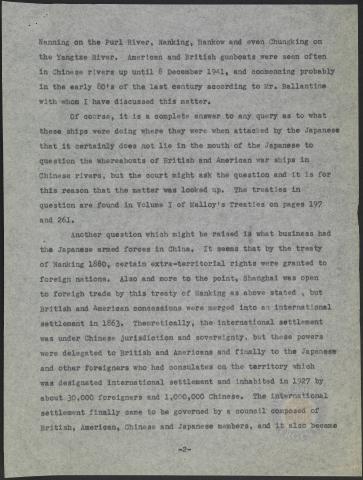
Page 2
| Parent | Why PANAY, LADYBIRD, BEE ships were near Yangtze River |
|---|---|
| Date | 27 June 1946 |
| Language | English |
| Collection | Tavenner Papers & IMTFE Official Records |
| Box | Box 3 |
| Folder | General Reports and Memoranda from June 1946 |
| Repository | University of Virginia Law Library |
Nanning on the Purl River, Nanking, Hankow and even Chungking on the Yangtze River. American and British gunboats were seen often in Chinese rivers up until 8 December 1941, and commencing probably in the early 80’s of the last century according to Mr. Ballantine with whom I have discussed this matter.
Of course, it is a complete answer to any query as to what these ships were doing where they were when attacked by the Japanese that it certainly does not lie in the mouth of the Japanese to question the whereabouts of British and American war ships in Chinese rivers, but the court might ask the question and it is for this reason that the matter was looked up. The treaties in question are found in Volume I of Malloy’s Treaties on pages 197 and 261.
Another question which might be raised is what business had the Japanese armed forces in China. IT seems that by the treaty of Nanking 1880, certain extra-territorial rights were granted to foreign nations. Also and more to the point, Shanghai was open to foreign trade by this treaty of Nanking as above stated, but British and American concessions were merged into an international settlement in 1863. Theoretically, the international settlement was under Chinese jurisdiction and sovereignty, but these powers were delegated to British and Americans and finally to the Japanese and other foreigners who had consulates on the territory which was designated international settlement and inhabited in 1927 by about 30,000 foreigners and 1,000,000 Chinese. The international settlement finally came to be governed by a council composed of British, American, Chinese and Japanese members, and it also became
-2-
